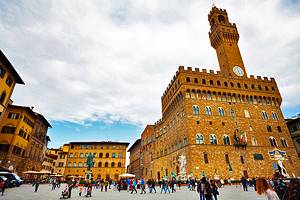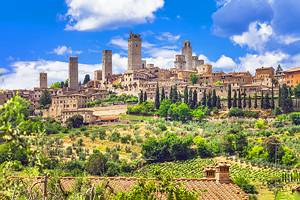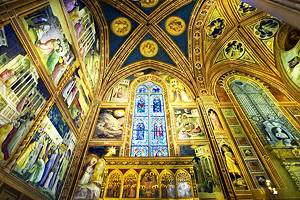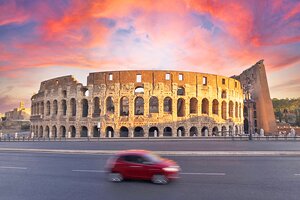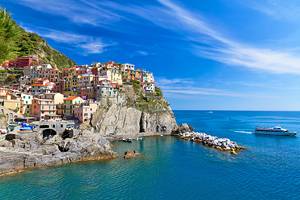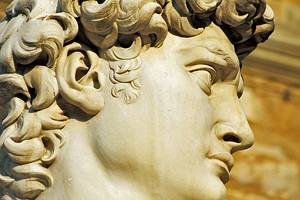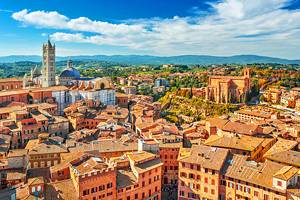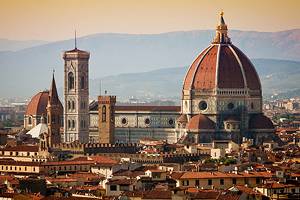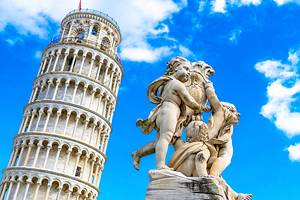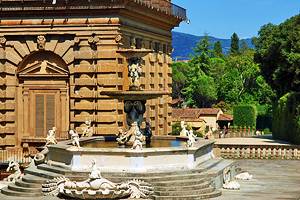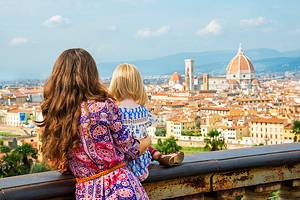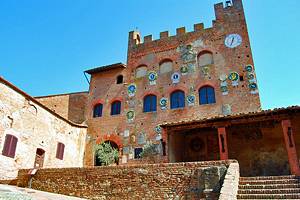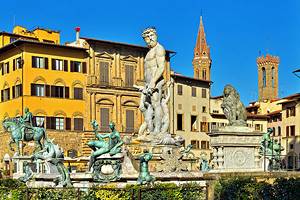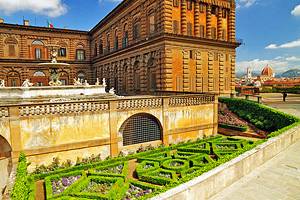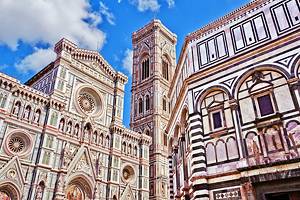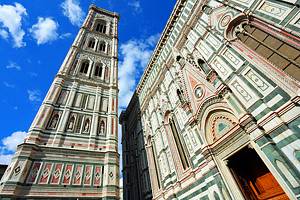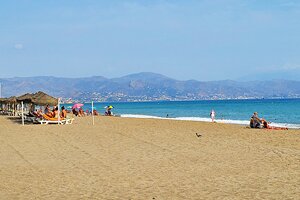Visiting the Uffizi Gallery in Florence: 12 Top Highlights
For art lovers, the Uffizi Gallery is the number-one attraction in Florence. More casual tourists, whether they see the gallery independently or on a guided tour, will at least want to see its highlights, including its most famous work: Botticelli's Birth of Venus.
Apart from its size, perhaps the most mind-boggling thing to know before visiting the Uffizi Gallery is that this was a private collection of one family - and only part of it, at that. More priceless art is tucked away in their other palaces and villas.
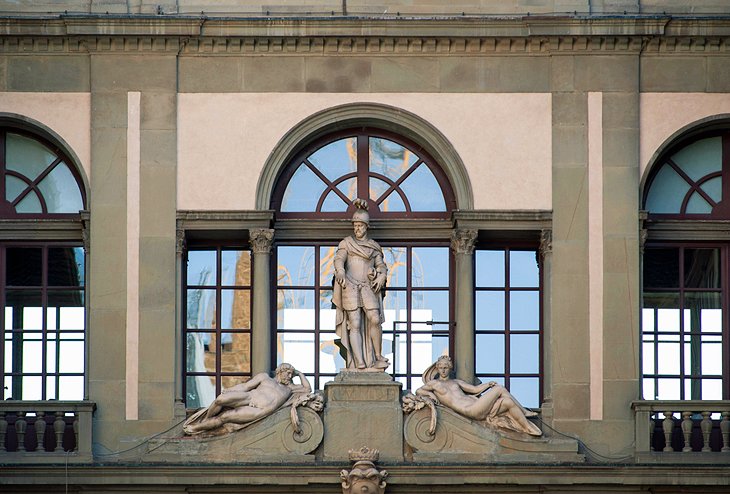
Beyond collectors, the Medici were great patrons of art, and without their patronage, many of these works might never have been created. At some point in your tour, stop for a brief nod of thanks to the woman who assured that this great collection - and the other Medici art works - would stay here in Florence.
The collections were bequeathed to the city by Anna Maria Ludovica von der Pfalz, the last heiress of the house of Medici, who died in 1743. And she stipulated that they must remain in Florence.
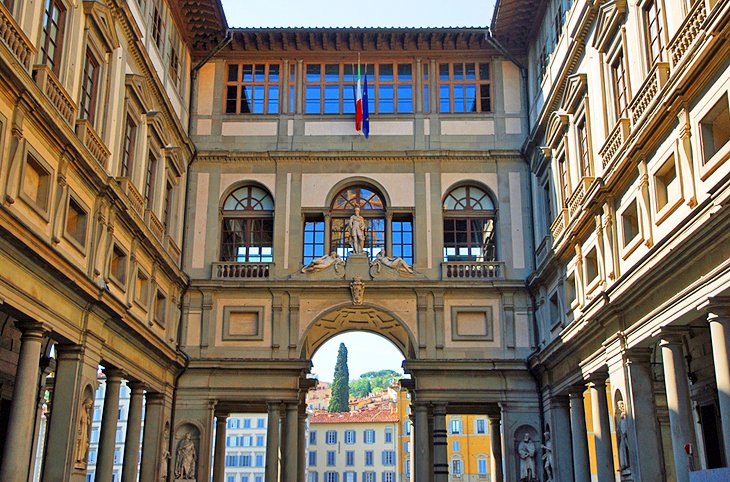
The Uffizi contains one of the world's most important collections of paintings. Besides Florentine and Italian art, it also includes a large number of foreign works and Classical sculpture.
Its greatest treasure is the unique collection of Florentine Renaissance painting, a vital part of this city's contribution to European art. These works from between about 1300 and 1500 set the path for the whole of Western art that followed.
In this guide, you'll find the highlights of the Uffizi's treasures, following the same order as the museum's own tour guideline. Artworks are shown in chronological order according to when they were painted, beginning with Room 2 on the second floor of the Uffizi.
However, beyond Room 13, the octagonal gallery in the Tribune, the works are no longer in chronological order but according to schools, regions, and countries. They cover works from about 1500 to 1700.
The project "New Uffizi" is in progress, with works of art being moved to other galleries, some galleries closed for renovation, and new sections opening, so while the museum is in transition, some of the paintings may not be in the order or in the galleries described here. Be sure to get a current gallery map at the time of your visit. But most of the highlights of the collections will be on display, and as you tour the Uffizi galleries, you can use this guide to follow the development of artistic styles and finesse, from the early two-dimensional, symmetrical, and stylized representations to lifelike portraits that seem ready to step from the canvas.
You'll notice that the settings change, too, becoming more natural and scenic, as well as more realistic. You will find the Uffizi more than just a tourist attraction and one of the important places to visit in Florence, but a fascinating course in the history of art.
- 1. Cimabue's Madonna Enthroned and 13th-Century Tuscan Art
- 2. Annunciation by Simone Martini & Lippo Memmi (14th-Century Tuscan Art)
- 3. Gentile da Fabriano's Adoration of the Magi
- 4. Domenico Veneziano's Virgin and Child
- 5. Portraits of the Duke and Duchess of Urbino by Piero della Francesca
- 6. Botticelli's Birth of Venus
- 7. The Annunciation by Leonardo da Vinci
- 8. The Tribuna
- 9. Albrecht Dürer's Adoration of the Magi
- 10. Michelangelo's Holy Family and the High Renaissance
- 11. Veronese's Holy Family with St. Barbara
- 12. Rembrandt Portraits
- Tips and Tours: How to Make the Most of Your Visit to the Uffizi Gallery
- Frequently Asked Questions
- When is the best time to visit the Uffizi Gallery?
- Can I get last-minute tickets?
- Is the Uffizi air-conditioned?
- Can I check my backpack or coat?
- Can I take photographs?
- Can I get something to eat or drink without leaving the museum?
- Address
1. Cimabue's Madonna Enthroned and 13th-Century Tuscan Art
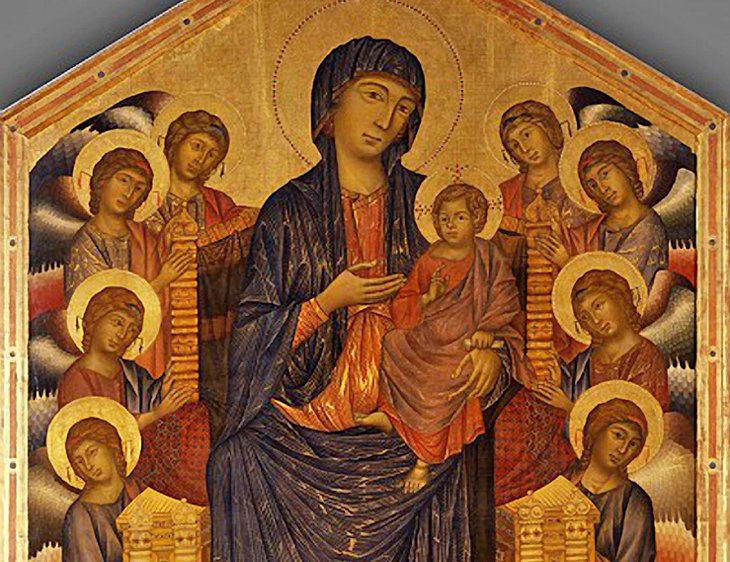
Room 2 of the Uffizi brings together three large Madonnas from around 1300, illustrating the debut of Tuscan art and one of its first high points. These three paintings, seen together, are the best introduction you could ask for, both to the Uffizi and to Renaissance art.
Cimabue's Madonna Enthroned (ca. 1275) is still entirely in the Byzantine tradition of painting the Virgin, who looks like a statue, aloof from reality and surrounded by symmetrically arranged angels. Cimabue's Infant Christ is dressed like a Roman general, and there is no sign of any tender exchange between mother and son.
By contrast, Duccio's Madonna Enthroned (1285) shows more movement, with gentle coloring and flowing lines, but still ethereal and aloof.
The first appearance of a human, realistic view is in the Madonna Enthroned by Giotto (ca. 1310). The throne seems almost within reach, the figures have weight and solidity, making eye-contact with one another and the viewer.
Giotto was the first artist to represent the Virgin as a woman with a physical presence, and even his minor figures are animated and have different facial expressions. He breaks away from the duller colors of Byzantine art, but the backgrounds remain the traditional gold.
Giotto's most important and historical achievement, however, was his composition. He was the first painter to create a well-defined space that considers the eye of the beholder, and his pyramidal composition created a model that would last for centuries.
Giotto's more personal, realistic style was to lead to a true Renaissance in art. From then on, painting would be an art in its own right, finally overshadowing sculpture.
2. Annunciation by Simone Martini & Lippo Memmi (14th-Century Tuscan Art)
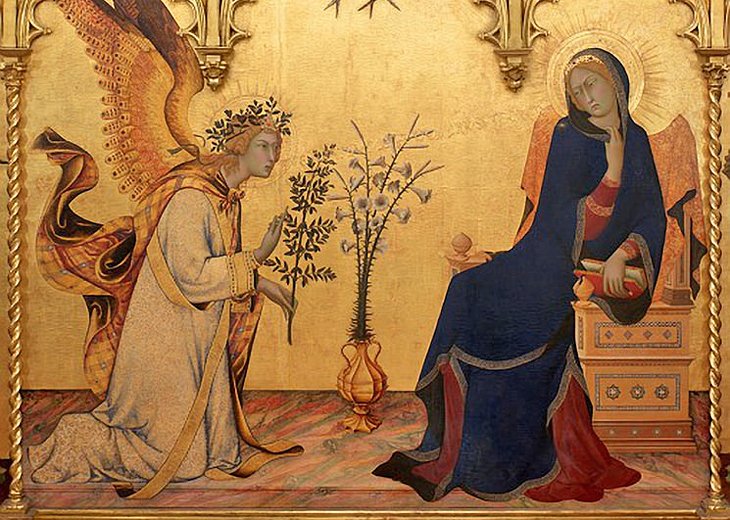
The next galleries show how other painters were changing from the old norms. Although Annunciation (about 1333) by the Sienese artist Simone Martini and his brother- in-law Lippo Memmi, is still very much Gothic in style, it already shows the transition to a New Realism.
The setting, with its turrets and gables, rings with Gothic architecture, but the angel's fluttering garment and the Virgin show great refinement and elegance. The movements have tenderness and sensitivity, but the delicate female images are still almost ethereal.
Among other 14th-century Sienese examples are the Madonna in Glory (1340) by Pietro Lorenzetti, a follower of Giotto, and scenes from the life of St. Nicholas by Ambrogio Lorenzetti, notable for attempts at using perspective.
The most prominent of Giotto's Florentine followers shown here are Bernardo Daddi (d. 1348) and Taddeo Gaddi (d. 1366), whose altarpieces use delicate colors and soft, graceful lines to show people and settings more realistically.
3. Gentile da Fabriano's Adoration of the Magi
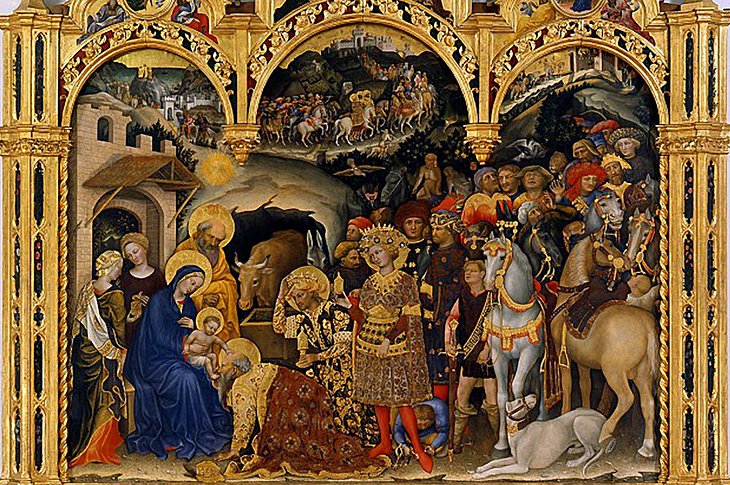
Gothic continued to dominate art into the early 15th century, but although Gentile da Fabriano's Adoration of the Magi (1423) still conveys the Gothic ideal of beauty, its lavish attention to detail marks the early transition from Gothic to Renaissance.
You can also see in the background, under the arches of the altarpiece's ornate frame, the beginnings of an attempt to show perspective as the procession grows smaller and almost disappears at the skyline. This is considered his masterpiece, and epitome of International Gothic painting.
Fabriano's contemporary, Masaccio, further revolutionized the art of perspective in his efforts to create three dimensions on a two-dimensional surface. Masaccio's Madonna and Child with St. Anne (ca. 1420), painted with Masolino, is one of his early works.
He ranks with Brunelleschi and Donatello as one of the founders of the Renaissance, a new art experience in reality, based on observing and recording nature accurately. You can see this in the relief-like modeling and realistic natural beauty of the faces and figures in Masaccio's altarpiece.
Look also for Coronation of the Virgin by Fra Angelico, the Dominican monk who was a contemporary of Masaccio, and whose mystic religious concept of art takes him in the opposite direction. But he was innovating in other ways. While he still uses gold backgrounds and ethereal draped figures, Fra Angelico's rich colors and circular arrangement of figures creates a unifying pictorial perspective.
4. Domenico Veneziano's Virgin and Child
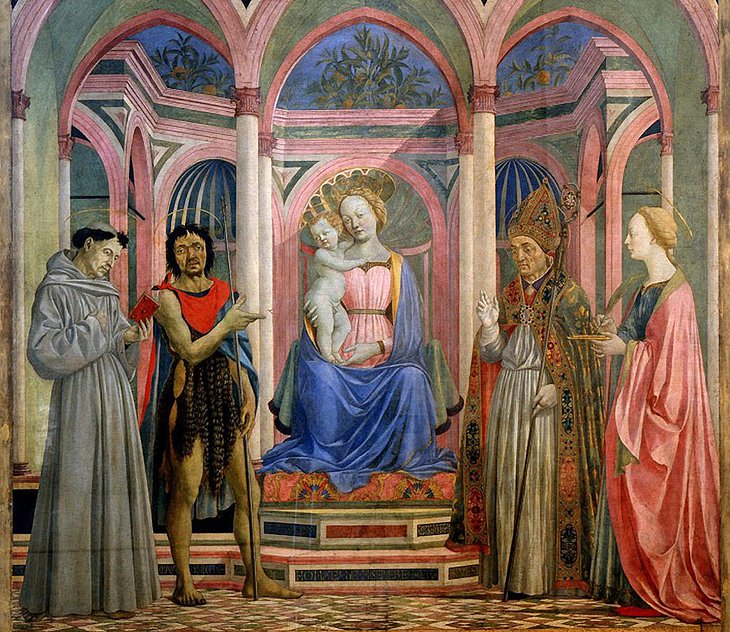
Abandoning the previous convention of a gold background for an altarpiece, in this 1445 work, Veneziano carries perspective to new heights by placing the saints harmoniously in a semi-circle, and enhances the effect of depth by the geometric patterns of the inlaid marble.
His main innovation, though, came as a master of realistic light and shade. His fine nuances and delicate shades of color were far ahead of the solid areas of strong color used by his Florentine contemporaries. Veneziano's use of light and colors influenced the work of Piero della Francesco, who often collaborated with him.
5. Portraits of the Duke and Duchess of Urbino by Piero della Francesca
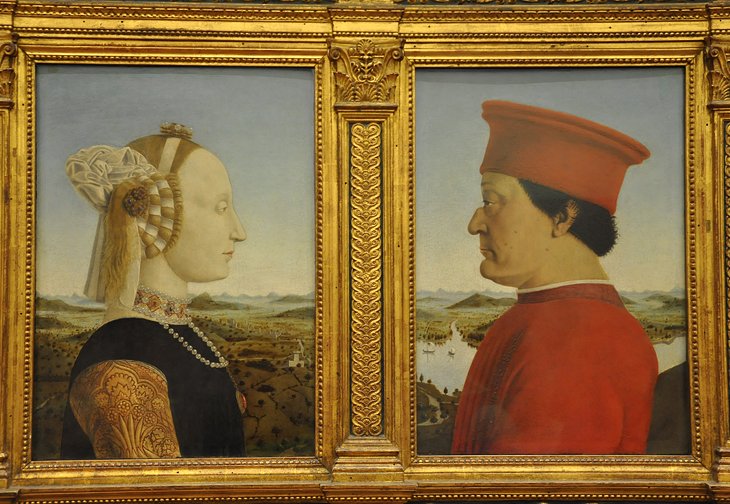
Portrait painting was another focus for early Renaissance art - and one that kept patrons happy. Portraits of the Duke and Duchess of Urbino by Piero della Francesca from around 1465 are a good example.
But Piero della Francesca did not flatter his sitters, showing the Duke's aquiline nose, wrinkles, thin lips, and stocky build. Notice the background, a rare example of early Renaissance landscape.
More like a portrait than religious art is Filippo Lippi's Virgin and Child (ca. 1460), an elegantly dressed young Mary with two smiling angels, a scene showing affection and eye contact between mother and child that reflects increasing secularized interpretations of religious themes.
Room 9 features huge panels of the Seven Virtues, by Piero del Pollaiolo. Actually, Piero painted only six, the seventh is one of the earliest works by Botticelli.
6. Botticelli's Birth of Venus
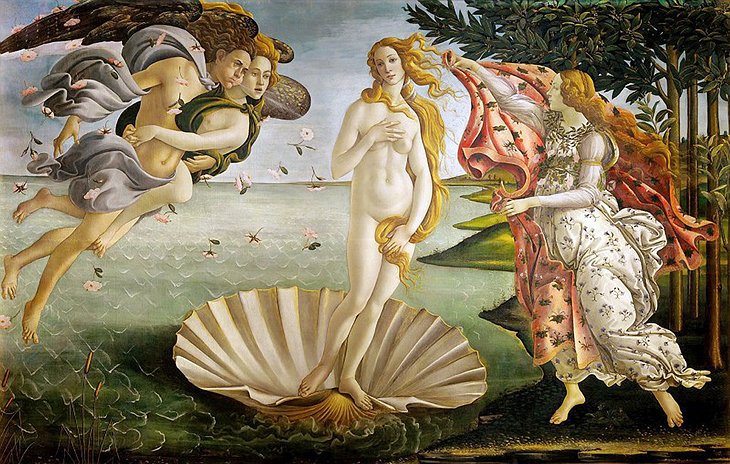
Which brings you into Florence's Golden Age and to one of its brightest stars, Botticelli. Along with their own aggrandizement, patrician Florentines were intensely interested in Classical literature and philosophy, and Botticelli's most famous works, Birth of Venus and Primavera, both commissioned by a Medici, reflect this.
In the Birth of Venus (1482/1483) Botticelli combines Classical and Christian thought in terms of Renaissance ideas, as a rebirth of the spirit from Classical mythology and Christian theology. He paints a female nude modeled on a Classical statue of the love goddess Venus, and implies a Christian baptism (as Christ is baptized in the Jordan).
Compare this Florentine thinking with the Flemish painter Rogier van der Weyden's Entombment (ca. 1450) and the Portinari Altarpiece by Hugo van der Goes, both in the same room, to appreciate how widely these Florentine ideas differed from those of Northern Europe. There, a nude would be unthinkable, and figures are concealed in drapery.
Botticelli painted the altarpiece Adoration of the Magi around 1475 when he was about 30, and the commission included portraying members of the Medici family and their associates among the onlookers.
He arranged the group in a pyramid with the holy family at its peak, below them the three kings - the three highest ranking Medici - and below them in order of rank more Medici and their friends. The actual theme seems to recede into the background, serving more as a pretext for a magnificent representation of the Medici and their supporters.
7. The Annunciation by Leonardo da Vinci
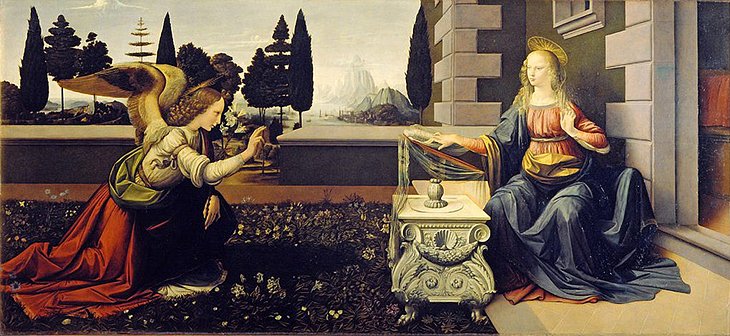
Leonardo da Vinci lived at a time of scientific discovery that questioned biblical accounts as the only model for explaining the universe. One main trait of his work, whether painting or sculpture, was bringing nature into his work in a way that made mystical religious themes more believable in a world that was rapidly becoming aware of science. In this early work, he shows the angel's wings as realistic bird wings covered in feathers.
Leonardo also sensitively captures the atmosphere of his time in the Adoration of the Magi (1481). In the center of this unfinished picture, the Madonna and child appear as a stabilizing influence, encircled by a heaving mass of people who greet the birth with wonder and amazement or with doubt and fear. Instead of a folk tale, the Nativity gains a new dimension of world redemption.
Room 16 is the last in the first part of the tour of the Uffizi, which is devoted to Florentine and Tuscan art from 1300 to 1500, mostly in chronological order. The art of the later Italian Renaissance follows in Room 25 onwards, arranged according to schools of painting.
Note that several of these galleries are currently closed for renovation, and all the works may not be shown, or may have been moved to other galleries. It is important to get a current gallery map at the time of your visit.
8. The Tribuna
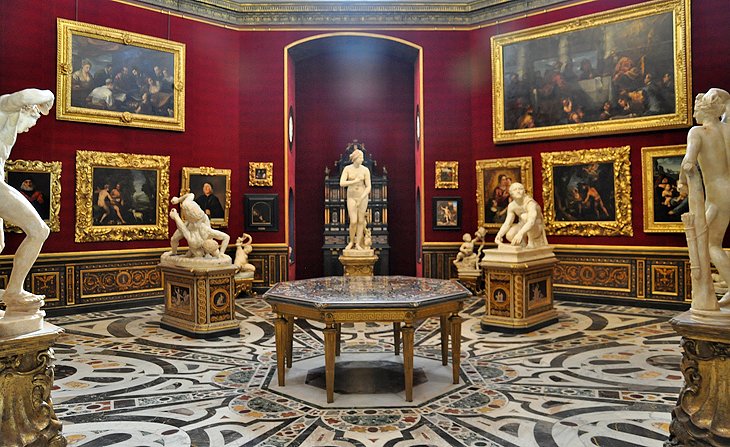
In the center of the stunning octagonal Tribuna, in itself a work of art, is the Medici Venus, the most famous Classical marble sculpture in Florence and thought to be a late Greek version of the Aphrodite of Cnidus by Praxiteles.
On the walls are Mannerist portraits of the Medici family from the mid-1500s, the most outstanding by Pontormo, Bronzino, and Vasari. Pietro Perugino, a student of Verrocchio and teacher of Raphael, is represented by Madonna with Saints and various portraits that show his three-dimensional realism and subdued color that paved the way for the Classical art of the High Renaissance.
Likewise, the turbulence and color of Luca Signorelli's style, as you'll see, his Holy Family (ca. 1495) and Madonna and Child, on the other hand, show much more turbulence and movement, an influence on the young Michelangelo.
9. Albrecht Dürer's Adoration of the Magi
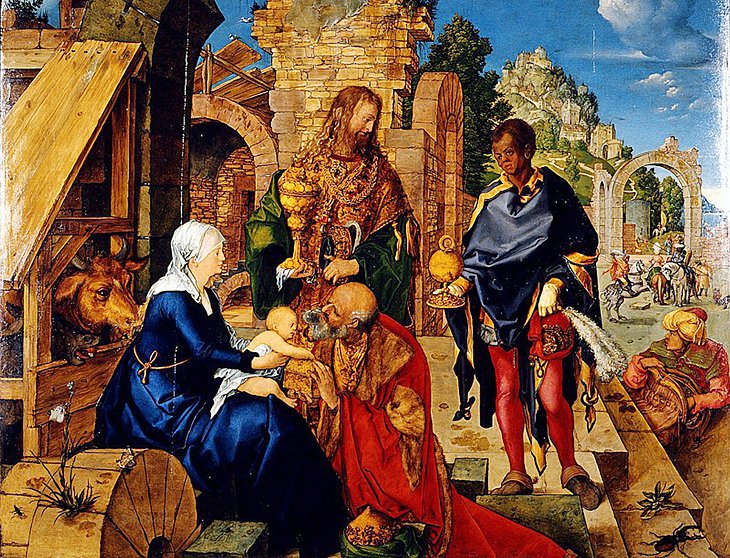
At the same time that Florentine and other Italian painters were changing the world of art, German artists were moving into their own Renaissance, as you'll see in masterpieces by Albrecht Dürer.
In Adoration of the Magi (1504), Dürer shows his understanding of both perspective and the play of light in the draping of clothing. He uses bright foreground colors to further the illusion of perspective. Like other German and northern European artists, he includes a wealth of details and strives for meticulous realism.
The Nuremberg artist is also represented by his Virgin and Child (1526) and by one of his earliest works still in existence, Portrait of the Father (1490).
Works by German artist Lucas Cranach include his portrait of Martin Luther and his wife Katharina, a self-portrait, an impressive Melanchthon, and a rather erotic Adam and Eve.
Venetian painting, characterized by soft color and balanced light, is represented by Giovanni Bellini's Religious Allegory (ca. 1485) and Giorgione's Portrait of a Maltese Horseman.
Also representing High Renaissance art in Northern Italy are religious works by Antonio Allegri, better known as Correggio, whose diagonal compositions, light effects, and unusual depths of perspective had a lasting influence on later Baroque painting.
10. Michelangelo's Holy Family and the High Renaissance
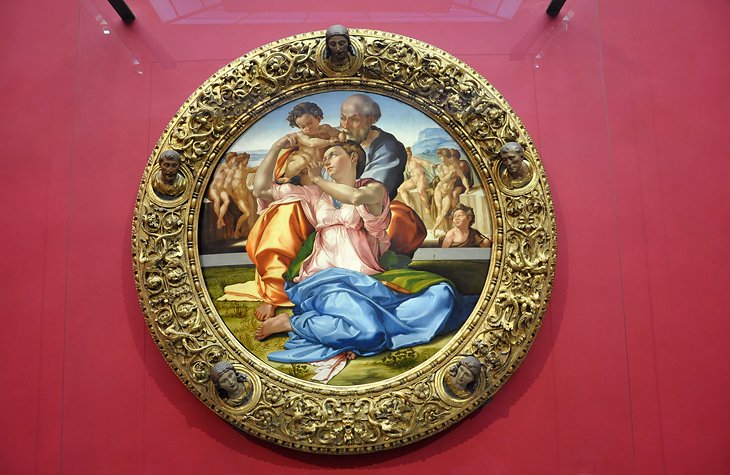
Michelangelo's Holy Family (1504/1505), known as the Doni Tondo, is devoid of any religious sentiment, the family appearing as though carved out of a block and showing Michelangelo's strong background in sculpture.
In this painting, you'll see hints of his masterwork on the ceiling of the Sistine Chapel in the profusion of naked figures and the bright, iridescent colors. The year of Raphael's death (1520) marked the beginning of Mannerism, the late phase of the Renaissance that lasted until about 1600.
Its departure from classical styles included unnatural forms and colors, shown by the almost two-dimensional composition of Rosso Fiorentino's Moses Defending the Daughters of Jethro (1523), whose figures seem unreal, almost like articulated dolls.
Three important works by Raphael from this same period include a self-portrait (ca. 1506), his charming Virgin Mary with the Goldfinch, and Pope Leo X with the Cardinals Giulio de' Medici and Luigi de'Rossi. Raphael depicts the Pope as an individual and intellectual, not simply a powerful leader.
Andrea del Sarto's Madonna with the Harpies, a monumental altarpiece that is typical of Florentine High Renaissance art, combines Raphael's soft technique with Michelangelo's monumentality and Leonardo da Vinci's atmospheric qualities.
Mannerism was the 16th-century transition between Renaissance and Baroque, turbulent and full of movement, distorting reality, and mystically interpreting piety. In Jacopo da Pontormo's Supper at Emmaus (ca. 1525), you'll see influence by his teachers Leonardo da Vinci and Andrea del Sarto fused with inspiration from the late work of Raphael and the monumental art of Michelangelo.
Works by the great Venetian painter Titian include Venus of Urbino (1538), Ludovico Beccadelli (1552), Venus and Cupid (1560), Eleonora Gonzaga della Rovere, Francesco Maria, Duke of Urbino, and La Flora, one of his finest portraits of women.
Venus of Urbino is especially interesting for the way Titian uses shades of red to pull the different parts of the picture together diagonally. Girolamo Francesco Maria Mazzola, known as Parmigianino, was influenced in turn by Correggio, the Roman High Renaissance, and Mannerism. Madonna with the Long Neck, painted between 1534 and 1540, is a good example of Mannerist distortion, with its elongated figures and strange light.
11. Veronese's Holy Family with St. Barbara
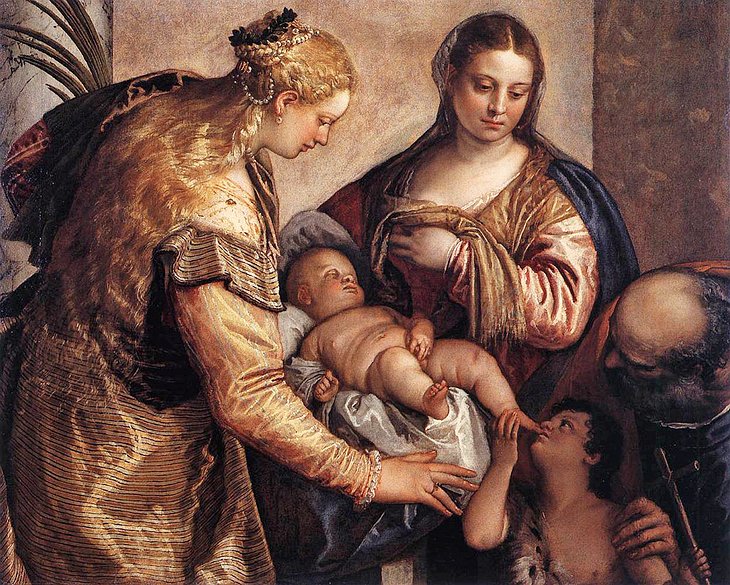
If your eyes haven't glazed over by now, look in the remaining galleries, which contain a variety of masterpieces, notably several by Venetian artists. Paolo Veronese's Holy Family with St. Barbara reflects the opulence of Venice in its golden tones and the saint's rich attire. The realistic figures and expressive faces are typical of Venetian painters.
Also in this gallery are Veronese's Annunciation and Martyrdom of St. Justina, and Tintoretto's Portrait of a Man. In the next room are several more by Tintoretto. Look, too, for Head of a Youth by Lorenzo Lotto (1505).
In succeeding galleries are works by Van Dyck and some of Rubens' finest works - Henry IV at Ivry and Henry IV Entering Paris, Isabella Brandt, and Entry of Ferdinand of Austria into Antwerp. In the Niobe Room, look for the finest classical sculpture in Florence after the Medici Venus, the Medici Vase from the second century BC.
12. Rembrandt Portraits
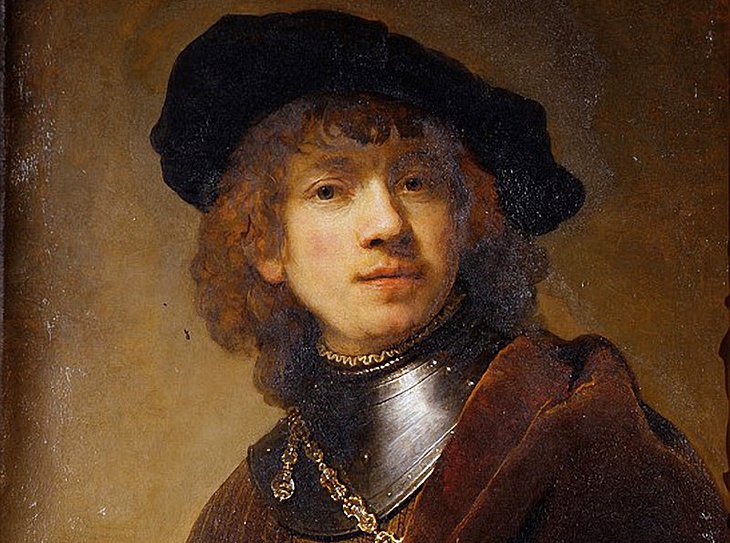
Throughout his career, which coincides with the Golden Age of Dutch painting, Rembrandt painted a series of self-portraits, two of which are shown in the Uffizi. As he records the changes in himself from the confident youth to the aging painter, he also records his journey as an artist. Shown with these is his Portrait of an Old Man, painted at about the same time as his later self-portrait.
Look here, also, for works by Caravaggio, including his Youthful Bacchus, Medusa, and The Sacrifice of Isaac. The startling realism of the two latter works is intensified by Caravaggio's brilliant sense of drama in the use of light and shadow.
Tips and Tours: How to Make the Most of Your Visit to the Uffizi Gallery
- Tours of the Uffizi Gallery: Visitors on a Skip the Line: Florence Uffizi Gallery Tour can bypass the long lines to see all the highlights and learn about the artists and their works with an art-expert guide. The 1.5-hour walking tour is available afternoons year-round, mornings, and evenings in the summer. The ticket allows you to remain after the tour to explore at leisure. Skip the Line: Florence Uffizi Gallery Tickets allow you to bypass the lines and explore the gallery at your own speed without a guide. Another option is to combine the Uffizi with the other major art gallery on a Skip the Line: Florence Accademia and Uffizi Gallery Tour, spending 1.5 hours in each museum with an art-expert guide. One walking tour is in the morning, the other in the afternoon, each time bypassing the waiting lines.
- Visiting the Uffizi Gallery on Your Own: Although you can expect lines for admission to be very long spring through fall, the longest are on weekends, Tuesdays, and in the morning. If you did not reserve tickets in advance, you can sometimes buy them in the museum ticket office at the Church of Orsanmichele, but it is closed on Sunday and there are no same-day tickets on weekends or holidays. They may not have any available, but it's worth a try. Audio tours are available, but the small guidebook sold at the entrance is more detailed.
Frequently Asked Questions
When is the best time to visit the Uffizi Gallery?
From early November through the end of February is the traditional "low season" for tourism in Florence, so tickets are easier to get on short notice, and museums are less crowded. Better yet, the admission price for the Uffizi drops from the '20 high season rate to '12 per person during these months. Whenever you go, but especially from May through October, reserve your tickets in advance to be sure of admission.
Can I get last-minute tickets?
Except on weekends and holidays, you can stand in line waiting for a space. If you get in line by 7:45am, half an hour before the museum opens in the morning, there is a chance of finding an available time slot with tickets available that day. But even that is unlikely to work in July or August. Also, you can sometimes buy same-day Uffizi tickets in the museum ticket office at the Church of Orsanmichele.
Is the Uffizi air-conditioned?
Sadly, no. That's another reason for not visiting Florence in July or August (although June can be just as hot).
Can I check my backpack or coat?
Yes, the Uffizi has a free coatroom. You will be required to check any packs or parcels.
Can I take photographs?
Yes, you can photograph for personal use as long as you don't use a flash, a tripod, or a selfie stick.
Can I get something to eat or drink without leaving the museum?
Yes, the Uffizi has a small cafeteria where you can buy sandwiches. You can also get coffee (if you drink it standing up, it costs a third of the price for drinking it at a table).
Address
- Piazzale degli Uffizi 6 (off Piazza Signoria), Florence
- Official site: https://www.uffizi.it/en




